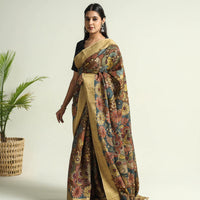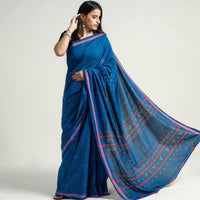Shop Traditional Pure Kalamkari Saree Online at iTokri
Pure Kalamkari sarees are more than just a piece of clothing; they are a testament to the rich cultural heritage and craftsmanship that have been passed down through generations in India. These traditional Kalamkari sarees, known for their intricate designs and vibrant colours, have a history that is as fascinating as the art itself. At
Shop Traditional Pure Kalamkari Saree Online at iTokri
Pure Kalamkari sarees are more than just a piece of clothing; they are a testament to the rich cultural heritage and craftsmanship that have been passed down through generations in India. These traditional Kalamkari sarees, known for their intricate designs and vibrant colours, have a history that is as fascinating as the art itself. At iTokri, we celebrate this tradition by bringing you a carefully curated collection of original Kalamkari sarees, handcrafted by skilled artisans who continue to keep this age-old craft alive. Our handpainted Kalamkari sarees are here to take aesthetics to a whole new level. Why wait much? Buy Kalamkari saree online at iTokri.
Explore Our Handpainted Original Kalamkari Collection Of Saree & More
From Pedana block print to stitched women kurta, we have the latest Kalamkari saree and fabric material collection that you would never want to miss!
1. Pedana Block Print Kalamkari Saree
Our Pedana Kalamkari Saree Block Print is a fashion statement. Each designer Kalamkari saree is handcrafted with highly intricate designs, which has elements of tradition with modernity, that brings ancient art of Kalamkari to life in brighter shades.
2. Kalamkari Fabrics
Apart from our handpainted Kalamkari sarees, we have a wide range of pure fabric cloth online that truly speaks beauty. Be it a work of art in designing or just something you have been looking for, our Kalamkari fabrics have stories to tell within every single brush stroke. Bask in the richness of hand-painted artistry in every yard from iTokri.
3. Kalamkari Stitched Suits
Celebrate the elegance and comfort of a Kalamkari stitched suit, where tradition meets effortless style. Handmade with love, these women kurta are embellished with fine Kalamkari designs on soft and breathable fabric – just perfect for any occasion. Heritage and culture have been sewn into every garment of these unique readymade wear garments.
4. Kalamkari Kurtis
Kalamkari kurtis are delectably rich in culture and style. From casual wear to festive wear, every women kurta is enhanced with bold Kalamkari prints that represent the most intricate parts of Indian culture.
5. Kalamkari Dupattas
Style your outfit with the vibrant shades of Kalamkari dupattas. Each one is a canvas of vibrant hand-painted artistry that lends an instant marking of sophistication to any ensemble. Best used for easy draping over traditional or modern attire.
6. Kalamkari Stoles
Adorn yourself with the elegance of splendid hand-painted Kalamkari stoles and make it that dash of culture and style in your outfit. It is as light as it is luxurious, a perfect fusion of art and practicality in beautiful accents for every season. Wear heritage proudly with iTokri Kalamkari saree origin.
7. Kalamkari Co-ord Set
Kalamkari Co-ord Set has added another dimension to the world of co-ord sets. It gives them a slightly traditional look and a bold hand-painted pattern, and makes them a statement when going for an event or just because you want to stand out from the crowd.
The Craftsmanship Behind Original Kalamkari in India
Behind every brushstroke of Kalamkari lies a rich history, where art and craftsmanship blend to create a timeless masterpiece. Shop the pure Kalamkari saree design at iTokri, where the intricate beauty of this ancient craft that has been passed down through generations in India.
1. Kalamkari Block Printing
Originated in Andhra Pradesh, Kalamkari block printing uses hand-carved wooden blocks to create intricate, nature-inspired designs on fabric.
2. Kalamkari Screen Printing
Yet another work of art, Kalamkari screen printing gives a refined technique, and uses screens to transfer detailed, vibrant patterns onto fabric, maintaining the essence of traditional art.
3. Srikalahasti Kalamkari
Last but not least, Srikalahasti Kalamkari is a hand-painted art form from Andhra Pradesh, known for its intricate depictions of mythological stories and nature using natural dyes.
Why Choose Kalamkari Sarees from iTokri?
At iTokri, we are committed to preserving the art of Kalamkari and supporting the artisans who create these beautiful pure Kalamkari sarees. When you purchase a Kalamkari saree from iTokri, you are not just buying a piece of clothing; you are investing in a piece of history, a work of art that has been lovingly crafted by skilled artisans.
The heart of our enterprise is sustainability, reflecting in the Indian handicrafts online we source and in our eco-friendly packaging.
Explore our designer Kalamkari saree collection today and find a perfect something to deck your wardrobe. Bring life to Indian culture by exploring the world of handpainted Kalamkari saree, including others.
You can even create unique Women’s Day gifts for the upcoming celebration and bandhani sarees to relive the essence of Rajasthani folk culture. From getting pure fabric cloth to gorgeous pieces of women kurta, iTokri will disappoint you, if you appreciate cultural richness atleast!

























































































